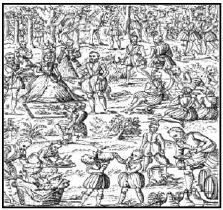All Exams >
UPSC >
Lucent for GK >
All Questions
All questions of The Three Orders for UPSC CSE Exam
A guild was an association of- a)monks.
- b)farmers.
- c)craft and industry.
- d)lords.
Correct answer is option 'C'. Can you explain this answer?
A guild was an association of
a)
monks.
b)
farmers.
c)
craft and industry.
d)
lords.
|
|
Sounak Nambiar answered |
Guild was a professional association that maintained formal guidelines for each craft. Guild was responsible to control the quality of the product, its price and its sale. Heads of all the guilds met formally at ‘guild-hall’. It was a building for ceremonial functions.
The first king who was declared the 'Holy Roman Emperor' was- a)Charlemagne.
- b)Louis I.
- c)Louis II.
- d)Louis III.
Correct answer is option 'A'. Can you explain this answer?
The first king who was declared the 'Holy Roman Emperor' was
a)
Charlemagne.
b)
Louis I.
c)
Louis II.
d)
Louis III.
|
|
Priya Menon answered |
The French had strong links and mutual understandings with the Church. This relationship was further strengthened when, in 800 AD, the Pope gave King Charlemagne the title of ‘Holy Roman Emperor’ to ensure his support.
There was a growing uncertainty about the value and purpose of monasticism by the- a)thirteenth century.
- b)fourteenth century.
- c)fifteenth century.
- d)sixteenth century.
Correct answer is option 'B'. Can you explain this answer?
There was a growing uncertainty about the value and purpose of monasticism by the
a)
thirteenth century.
b)
fourteenth century.
c)
fifteenth century.
d)
sixteenth century.
|
|
Arshiya Kulkarni answered |
The diminishing popularity of the monotheism could be seen in many of the writings. For example in England, Langland’s poem, 'Piers Plowman' contrasted the ease and luxury of the lives of some monks with the ‘pure faith’ of ‘simple ploughmen and shepherds and poor common labourers.’ Chaucer wrote the 'Canterbury Tales', which had comic portraits of a nun, a monk and a friar.
According to French priests the basis of classification among the three orders was- a)education.
- b)race.
- c)wealth.
- d)nature of work.
Correct answer is option 'D'. Can you explain this answer?
According to French priests the basis of classification among the three orders was
a)
education.
b)
race.
c)
wealth.
d)
nature of work.
|
|
Pooja Choudhury answered |
The three orders of society were the clergy, the nobility and the peasantry. The clergy or the religious people were at the top of the hierarchy, followed by the nobility, which constituted king and his courtiers, and lastly were the peasants and other masses.
Europe witnessed change in land use “switch from a two-field to a three-field system” during the- a)10th century.
- b)11th century.
- c)12th century.
- d)13th century.
Correct answer is option 'B'. Can you explain this answer?
Europe witnessed change in land use “switch from a two-field to a three-field system” during the
a)
10th century.
b)
11th century.
c)
12th century.
d)
13th century.
|
|
Prisha Tiwari answered |
The change in the land use, during the 11th century, brought many benefits and more yields. It enabled peasants to use a field two years out of three if they planted one crop in autumn, and a different crop in spring a year and a half later, which meant that farmers could break their holdings into three fields. They could plant one with wheat or rye in autumn for human consumption. The second one could be used in spring to raise peas, beans and lentils, for human use, and oats and barley for the horses. The third field lay fallow. Each year they rotated the use among the three fields.
The famous book Feudal Society, which dealt with the French society, was written by:- a)James Cunnigham
- b)Alexander Cunnigham
- c)James Bloch
- d)Marc Bloch
Correct answer is option 'D'. Can you explain this answer?
The famous book Feudal Society, which dealt with the French society, was written by:
a)
James Cunnigham
b)
Alexander Cunnigham
c)
James Bloch
d)
Marc Bloch
|
|
Tarun Basu answered |
Marc Bloch’s 'Feudal Society' is about European, particularly French, society between 900 CE and 1300 CE, describing in remarkable detail, the social relations and hierarchies, land management and popular culture of the period.
We see the rise of absolute monarchy in Europe in the- a)15th & 16th centuries.
- b)13th & 14th centuries.
- c)12th & 13th centuries.
- d)16th & 17th centuries.
Correct answer is option 'A'. Can you explain this answer?
We see the rise of absolute monarchy in Europe in the
a)
15th & 16th centuries.
b)
13th & 14th centuries.
c)
12th & 13th centuries.
d)
16th & 17th centuries.
|
|
Aryan Chavan answered |
The 15th and 16th centuries saw the European kings strengthening their military and financial powers.
The land granted by the lord to the knights was called:- a)Fief
- b)Feud
- c)Seigneur
- d)Manor
Correct answer is option 'A'. Can you explain this answer?
The land granted by the lord to the knights was called:
a)
Fief
b)
Feud
c)
Seigneur
d)
Manor
|
|
Nisha Sengupta answered |
The fief was inherited land, which extended to between 1,000-2,000 acres, including a house for the knight and his family, a church and other establishments to house his dependants, besides a watermill and a wine-press. The land of the fief was cultivated by peasants.
Read the following extract carefully and answer the following question by choosing the correct option:Gaul, a province of the Roman Empire, had two extensive coastlines, mountain ranges, longrivers, forests and large tracts of plains suited to agriculture.The Franks, a Germanic tribe, gave their name to Gaul, making it ‘France’. From the sixth century, this region was a kingdom ruled by Frankish/ French kings, who were Christian. The French had very strong links with the Church, which were further strengthened when in 800 the Pope gave King Charlemagne the title of ‘Holy Roman Emperor’, to ensure his support. Across a narrow channel lay the island of England–Scotland, which in the eleventh century was conquered by a duke from the French province of Normandy.Q. Who were Franks?- a)A Portuguese tribe
- b)A Spanish tribe
- c)A German tribe
- d)A French tribe
Correct answer is option 'C'. Can you explain this answer?
Read the following extract carefully and answer the following question by choosing the correct option:
Gaul, a province of the Roman Empire, had two extensive coastlines, mountain ranges, long
rivers, forests and large tracts of plains suited to agriculture.
The Franks, a Germanic tribe, gave their name to Gaul, making it ‘France’. From the sixth century, this region was a kingdom ruled by Frankish/ French kings, who were Christian. The French had very strong links with the Church, which were further strengthened when in 800 the Pope gave King Charlemagne the title of ‘Holy Roman Emperor’, to ensure his support. Across a narrow channel lay the island of England–Scotland, which in the eleventh century was conquered by a duke from the French province of Normandy.
Q. Who were Franks?
a)
A Portuguese tribe
b)
A Spanish tribe
c)
A German tribe
d)
A French tribe
|
|
Arun Yadav answered |
The Franks were a group of Germanic peoples whose name was first mentioned in 3rd-century Roman sources, and associated with tribes between the Lower Rhine and the Ems River, on the edge of the Roman Empire.
One of the gradual changes that affected the social and economic ties between the lords and the vassals was
- a)agricultural technology.
- b)environment.
- c)land use.
- d)new towns.
Correct answer is option 'B'. Can you explain this answer?
One of the gradual changes that affected the social and economic ties between the lords and the vassals was
a)
agricultural technology.
b)
environment.
c)
land use.
d)
new towns.
|
|
Niharika Shah answered |
Around 11th century, several processes were transforming the social system. Changes in the environment were gradual and almost barely visible.
Read the following extract carefully and answer the following question by choosing the correct option:Gaul, a province of the Roman Empire, had two extensive coastlines, mountain ranges, longrivers, forests and large tracts of plains suited to agriculture.The Franks, a Germanic tribe, gave their name to Gaul, making it ‘France’. From the sixth century, this region was a kingdom ruled by Frankish/ French kings, who were Christian. The French had very strong links with the Church, which were further strengthened when in 800 the Pope gave King Charlemagne the title of ‘Holy Roman Emperor’, to ensure his support. Across a narrow channel lay the island of England–Scotland, which in the eleventh century was conquered by a duke from the French province of Normandy.Q. Who were French Kings?- a)Jews
- b)Christians
- c)Muslims
- d)Protestants
Correct answer is option 'B'. Can you explain this answer?
Read the following extract carefully and answer the following question by choosing the correct option:
Gaul, a province of the Roman Empire, had two extensive coastlines, mountain ranges, long
rivers, forests and large tracts of plains suited to agriculture.
The Franks, a Germanic tribe, gave their name to Gaul, making it ‘France’. From the sixth century, this region was a kingdom ruled by Frankish/ French kings, who were Christian. The French had very strong links with the Church, which were further strengthened when in 800 the Pope gave King Charlemagne the title of ‘Holy Roman Emperor’, to ensure his support. Across a narrow channel lay the island of England–Scotland, which in the eleventh century was conquered by a duke from the French province of Normandy.
Q. Who were French Kings?
a)
Jews
b)
Christians
c)
Muslims
d)
Protestants
|
|
Arun Yadav answered |
The French monarch held the title “Most Christian King”. This didn’t prevent Francis from making war on the papacy, though he never did so as violently as Charles, the Holy Roman Emperor, whose troops sacked Rome in 1527, forcing the pope to take refuge in the Castel Sant'angelo.
Study this picture carefully and answer the following questions by choosing the correct option: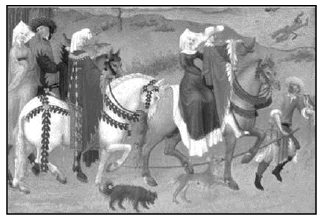 Q. An elaborately dressed group of noblemen and noblewomen are shown carrying:
Q. An elaborately dressed group of noblemen and noblewomen are shown carrying:- a)Golf Sticks
- b)Falcons
- c)Arrows
- d)None of these
Correct answer is option 'B'. Can you explain this answer?
Study this picture carefully and answer the following questions by choosing the correct option:

Q. An elaborately dressed group of noblemen and noblewomen are shown carrying:
a)
Golf Sticks
b)
Falcons
c)
Arrows
d)
None of these
|
|
Jitendra Mandal answered |
B) Falcons
Study this picture carefully and answer the following questions by choosing the correct option: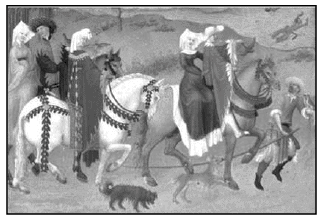 Q. The above picture is an illustration of:
Q. The above picture is an illustration of:- a)Fourteen Century
- b)Fifteen Century
- c)Sixteen Century
- d)None of these.
Correct answer is option 'B'. Can you explain this answer?
Study this picture carefully and answer the following questions by choosing the correct option:

Q. The above picture is an illustration of:
a)
Fourteen Century
b)
Fifteen Century
c)
Sixteen Century
d)
None of these.
|
|
Arun Yadav answered |
The 15th century was the century which spans the Julian dates from January 1, 1401 to December 31, 1500. In Europe, the 15th century includes parts of the Late Middle Ages, the Early Renaissance, and the early modern period.
Study the below picture from The Three Order carefully and answer the following question by choosing the correct option: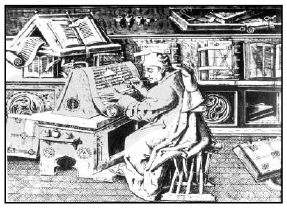 Q. Where do you think the person is working?
Q. Where do you think the person is working?- a)Queen Elizabeth Palace
- b)Benedictine Monasteries
- c)An Old Church
- d)None of these
Correct answer is option 'B'. Can you explain this answer?
Study the below picture from The Three Order carefully and answer the following question by choosing the correct option:

Q. Where do you think the person is working?
a)
Queen Elizabeth Palace
b)
Benedictine Monasteries
c)
An Old Church
d)
None of these
|
|
Arun Yadav answered |
Benedictines, in addition to their monastic life of contemplation and celebration of the liturgy, are engaged in various activities, including education, scholarship, and parochial and missionary work.
Read the following extract carefully and answer the following question by choosing the correct option:Gaul, a province of the Roman Empire, had two extensive coastlines, mountain ranges, longrivers, forests and large tracts of plains suited to agriculture.The Franks, a Germanic tribe, gave their name to Gaul, making it ‘France’. From the sixth century, this region was a kingdom ruled by Frankish/ French kings, who were Christian. The French had very strong links with the Church, which were further strengthened when in 800 the Pope gave King Charlemagne the title of ‘Holy Roman Emperor’, to ensure his support. Across a narrow channel lay the island of England–Scotland, which in the eleventh century was conquered by a duke from the French province of Normandy.Q. Who gave the title of ‘Holy Roman Emperor’ to king Charlemagne?- a)The Clergy
- b)The Priest
- c)Pope
- d)The Nobles
Correct answer is option 'C'. Can you explain this answer?
Read the following extract carefully and answer the following question by choosing the correct option:
Gaul, a province of the Roman Empire, had two extensive coastlines, mountain ranges, long
rivers, forests and large tracts of plains suited to agriculture.
The Franks, a Germanic tribe, gave their name to Gaul, making it ‘France’. From the sixth century, this region was a kingdom ruled by Frankish/ French kings, who were Christian. The French had very strong links with the Church, which were further strengthened when in 800 the Pope gave King Charlemagne the title of ‘Holy Roman Emperor’, to ensure his support. Across a narrow channel lay the island of England–Scotland, which in the eleventh century was conquered by a duke from the French province of Normandy.
Q. Who gave the title of ‘Holy Roman Emperor’ to king Charlemagne?
a)
The Clergy
b)
The Priest
c)
Pope
d)
The Nobles
|
|
Arun Yadav answered |
On 25 December 800, Pope Leo III crowned the Frankish king Charlemagne as emperor, reviving the title in Western Europe more than three years after the fall of the former ancient Western Roman Empire in 476.
Study this picture carefully and answer the following questions by choosing the correct option: Q. The above picture illustrates a scene and popularly known as:
Q. The above picture illustrates a scene and popularly known as:- a)Horse Riding Party
- b)Playing Golf Party
- c)Hunting Party
- d)British Family Party
Correct answer is option 'C'. Can you explain this answer?
Study this picture carefully and answer the following questions by choosing the correct option:

Q. The above picture illustrates a scene and popularly known as:
a)
Horse Riding Party
b)
Playing Golf Party
c)
Hunting Party
d)
British Family Party
|
|
Rajesh Gupta answered |
Hunting party, a group of people organized to hunt wild game. Mixed hunting party, a group of hunting birds. Political parties with a pro-hunting platform such as the French Hunting, Fishing, Nature, Tradition.
Look at the following picture carefully from The Three Orders and answer the following questions by choosing the correct option: Q. What do you think the people are doing in this picture?
Q. What do you think the people are doing in this picture?- a)Shopping in the market
- b)Holding Picnic
- c)Enjoying on a Beach
- d)None of these
Correct answer is option 'B'. Can you explain this answer?
Look at the following picture carefully from The Three Orders and answer the following questions by choosing the correct option:

Q. What do you think the people are doing in this picture?
a)
Shopping in the market
b)
Holding Picnic
c)
Enjoying on a Beach
d)
None of these
|
|
Lavkush Banshiwal answered |
A
Study the below picture from The Three Order carefully and answer the following question by choosing the correct option: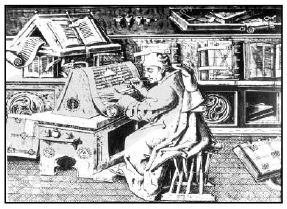 Q. The picture shows a man sitting on a table. Who the man is looking like?
Q. The picture shows a man sitting on a table. Who the man is looking like?- a)The King George
- b)A Benedictine Monk
- c)A Painter of England
- d)None of these
Correct answer is option 'B'. Can you explain this answer?
Study the below picture from The Three Order carefully and answer the following question by choosing the correct option:

Q. The picture shows a man sitting on a table. Who the man is looking like?
a)
The King George
b)
A Benedictine Monk
c)
A Painter of England
d)
None of these
|
|
Rajesh Gupta answered |
The primary work of any Benedictine monk is the worship of God in the Divine Office and the Mass and St Benedict says that nothing should be preferred to this. Together with this goes the love and service of Christ in the community and its guests.
Study this picture carefully and answer the following questions by choosing the correct option: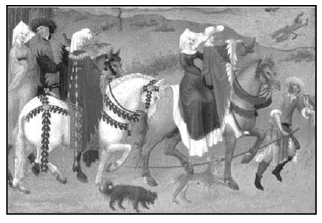 Q. The noblemen and noblewomen are shown accompanying:
Q. The noblemen and noblewomen are shown accompanying:- a)Their servants and their dogs
- b)The Royal family
- c)Soldiers
- d)None of these
Correct answer is option 'A'. Can you explain this answer?
Study this picture carefully and answer the following questions by choosing the correct option:

Q. The noblemen and noblewomen are shown accompanying:
a)
Their servants and their dogs
b)
The Royal family
c)
Soldiers
d)
None of these

|
Parthi Sharma answered |
Option A is the correct answer because during 12th century when there are three orders in the European society , which are :
The Clergy
The Nobles
and The Peasants or slaves.
among them Nobles are the man who have centered role in all social processes. This is because they controlled land.
This picture show the royal status of Nobles because the Noble enjoyed a privileged status. He had absoulte control over his property in perpetuity. He could raise troops called 'Feudal Levies '. The lord held his own courts of justice and could even coin his own money.
The Clergy
The Nobles
and The Peasants or slaves.
among them Nobles are the man who have centered role in all social processes. This is because they controlled land.
This picture show the royal status of Nobles because the Noble enjoyed a privileged status. He had absoulte control over his property in perpetuity. He could raise troops called 'Feudal Levies '. The lord held his own courts of justice and could even coin his own money.
Look at the following picture carefully from The Three Orders and answer the following questions by choosing the correct option: Q. Which century do you think this picture belongs to?
Q. Which century do you think this picture belongs to?- a)15th Century
- b)16th Century
- c)17th Century
- d)None of these
Correct answer is option 'B'. Can you explain this answer?
Look at the following picture carefully from The Three Orders and answer the following questions by choosing the correct option:

Q. Which century do you think this picture belongs to?
a)
15th Century
b)
16th Century
c)
17th Century
d)
None of these
|
|
Rajesh Gupta answered |
The 16th century begins with the Julian year 1501 and ends with either the Julian or the Gregorian year 1600. The 16th century is regarded by historians as the century in which the rise of Western civilization and the Age of the Islamic Gunpowders occurred.
Study the below picture from The Three Order carefully and answer the following question by choosing the correct option: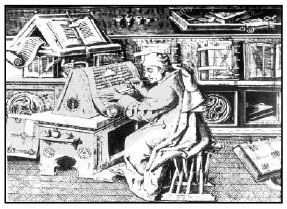 Q. What do you think the person shown in the picture is doing?
Q. What do you think the person shown in the picture is doing?- a)Painting an art piece
- b)Working on a manuscript
- c)Decoding a language
- d)None of these
Correct answer is option 'B'. Can you explain this answer?
Study the below picture from The Three Order carefully and answer the following question by choosing the correct option:

Q. What do you think the person shown in the picture is doing?
a)
Painting an art piece
b)
Working on a manuscript
c)
Decoding a language
d)
None of these
|
|
Rajesh Gupta answered |
‘Working manuscript’ is a modern term sometimes used to denote a manuscript work or text that is still in progress.
Look at the following picture carefully from The Three Orders and answer the following questions by choosing the correct option: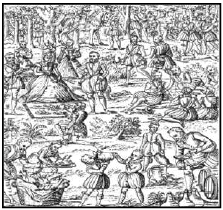 Q. The painting is showing a famous ruler. Whom do you think he/ she is?
Q. The painting is showing a famous ruler. Whom do you think he/ she is?- a)Queen Elizabeth I
- b)Queen Elizabeth II
- c)King George I
- d)King George II
Correct answer is option 'A'. Can you explain this answer?
Look at the following picture carefully from The Three Orders and answer the following questions by choosing the correct option:

Q. The painting is showing a famous ruler. Whom do you think he/ she is?
a)
Queen Elizabeth I
b)
Queen Elizabeth II
c)
King George I
d)
King George II
|
|
Arun Yadav answered |
During her reign, Elizabeth I established Protestantism in England; defeated the Spanish Armada in 1588; maintained peace inside her previously divided country; and created an environment where the arts flourished. She was sometimes called the "Virgin Queen", as she never married.
Study the below picture from The Three Order carefully and answer the following question by choosing the correct option: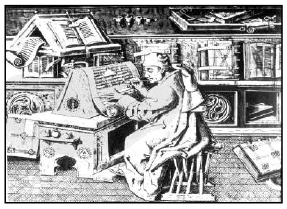 Q. In Benedictine monasteries there was a manuscript with 73 chapters of rules.
Q. In Benedictine monasteries there was a manuscript with 73 chapters of rules.- a)The statement is True
- b)The statement is False
- c)The statement is partially True
- d)None of these
Correct answer is option 'A'. Can you explain this answer?
Study the below picture from The Three Order carefully and answer the following question by choosing the correct option:

Q. In Benedictine monasteries there was a manuscript with 73 chapters of rules.
a)
The statement is True
b)
The statement is False
c)
The statement is partially True
d)
None of these
|
|
Rajesh Gupta answered |
Benedictine monasteries, there was a manuscript with 73 chapters of rules which were followed by monks for many centuries. Here are some of the rules they had to follow.
Chapter 6: Permission to speak should rarely be granted to monks.
Chapter 7: Humility means obedience.
Chapter 33: No monk should own private property.
Chapter 47: Idleness is the enemy of the soul, so friars and sisters should be occupied at certain times in manual labour, and at fixed hours in sacred reading.
Chapter 48: The monastery should be laid out in such a way that all necessities be found within its bounds: water, mill, garden, workshops.
Chapter doubts & questions for The Three Orders - Lucent for GK 2025 is part of UPSC CSE exam preparation. The chapters have been prepared according to the UPSC CSE exam syllabus. The Chapter doubts & questions, notes, tests & MCQs are made for UPSC CSE 2025 Exam. Find important definitions, questions, notes, meanings, examples, exercises, MCQs and online tests here.
Chapter doubts & questions of The Three Orders - Lucent for GK in English & Hindi are available as part of UPSC CSE exam.
Download more important topics, notes, lectures and mock test series for UPSC CSE Exam by signing up for free.
Lucent for GK
643 videos|791 docs|420 tests
|
Related UPSC CSE Content
Signup to see your scores go up within 7 days!
Study with 1000+ FREE Docs, Videos & Tests
10M+ students study on EduRev

Contact Support
Our team is online on weekdays between 10 AM - 7 PM
Typical reply within 3 hours
|
Free Exam Preparation
at your Fingertips!
Access Free Study Material - Test Series, Structured Courses, Free Videos & Study Notes and Prepare for Your Exam With Ease

 Join the 10M+ students on EduRev
Join the 10M+ students on EduRev
|

|
Forgot Password
OR
Signup to see your scores
go up within 7 days!
Access 1000+ FREE Docs, Videos and Tests
Takes less than 10 seconds to signup

